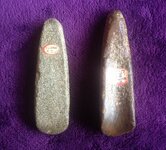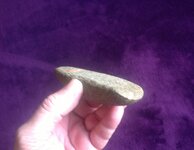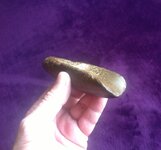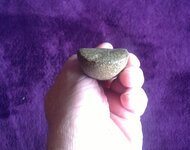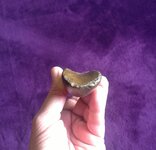Navigation
Install the app
How to install the app on iOS
Follow along with the video below to see how to install our site as a web app on your home screen.
Note: This feature may not be available in some browsers.
More options
You are using an out of date browser. It may not display this or other websites correctly.
You should upgrade or use an alternative browser.
You should upgrade or use an alternative browser.
Celts and adze bits
- Thread starter NC field hunter
- Start date
- Jan 27, 2009
- 18,792
- 11,909
- 🥇 Banner finds
- 1
- Detector(s) used
- Tesoro Conquistador freq shift
Fisher F75
Garrett AT-Pro
Garet carrot
Neodymium magnets
5' Probe
- Primary Interest:
- All Treasure Hunting
NC field hunter
Silver Member
- Jul 29, 2012
- 4,227
- 1,626
- Thread starter
- #3
Tnmountains said:
I call Celt. Why? Because the bit has no curvature. Now, your turn.
tomclark
Bronze Member
- Dec 18, 2006
- 1,177
- 1,641
- Detector(s) used
- ShadowX2, TEJON, Eyes, Pony Shovel
- Primary Interest:
- Other
I would state that adze bits do NOT have to be curved, in fact if they are curved I'd call it a gouge. All the adzes I've found (shell), the bit is not curved, but the body of the tool sometimes is. Adzes are for removing wood, not chopping, and the bit is beveled (on only one side of the bit).
I detest the term celt because I feel it too broad a term. It's either an axe or an adze.
I detest the term celt because I feel it too broad a term. It's either an axe or an adze.
NC field hunter
Silver Member
- Jul 29, 2012
- 4,227
- 1,626
- Thread starter
- #5
tomclark said:I would state that adze bits do NOT have to be curved, in fact if they are curved I'd call it a gouge. All the adzes I've found (shell), the bit is not curved, but the body of the tool sometimes is. Adzes are for removing wood, not chopping, and the bit is beveled (on only one side of the bit).
I detest the term celt because I feel it too broad a term. It's either an axe or an adze.
Me to brother. Celt could be any number of ungrooved things. You do agree mine are native American though?
tomclark
Bronze Member
- Dec 18, 2006
- 1,177
- 1,641
- Detector(s) used
- ShadowX2, TEJON, Eyes, Pony Shovel
- Primary Interest:
- Other
I think so. Looks like damaged/bashed axe or maybe preform axe. They usually finish off smoothing the abraded/ground lines on the sides before use and that bit looks like it's been through hale or wasn't finished, was pecking it into shape....? I can only guess, would love to hold and look at items like that in my hand. That other piece is quite interesting I'd like to see a closer pic of the left side of it...
NC field hunter
Silver Member
- Jul 29, 2012
- 4,227
- 1,626
- Thread starter
- #7
tomclark said:I think so. Looks like damaged/bashed axe or maybe preform axe. They usually finish off smoothing the abraded/ground lines on the sides before use and that bit looks like it's been through hale or wasn't finished, was pecking it into shape....? I can only guess, would love to hold and look at items like that in my hand. That other piece is quite interesting I'd like to see a closer pic of the left side of it...
The large one has been hit by a tractor. The smaller, I'll get you pics soon. I have another to post in question. My pops said is just a rock. I'm not sure , here goes nothing !!




GatorBoy
Gold Member
- May 28, 2012
- 14,716
- 6,156
- Primary Interest:
- All Treasure Hunting
well put Tom. Shell was being used as a replacement material. The task was the same..so the manufacture was as well.I would state that adze bits do NOT have to be curved, in fact if they are curved I'd call it a gouge. All the adzes I've found (shell), the bit is not curved, but the body of the tool sometimes is. Adzes are for removing wood, not chopping, and the bit is beveled (on only one side of the bit).
I detest the term celt because I feel it too broad a term. It's either an axe or an adze.
Last edited:
NC field hunter
Silver Member
- Jul 29, 2012
- 4,227
- 1,626
- Thread starter
- #9
This is an old one. The last pic that I have posted here has made it's way outdoors. Never figured out what it was. I'm thinking natural.
- Jan 27, 2009
- 18,792
- 11,909
- 🥇 Banner finds
- 1
- Detector(s) used
- Tesoro Conquistador freq shift
Fisher F75
Garrett AT-Pro
Garet carrot
Neodymium magnets
5' Probe
- Primary Interest:
- All Treasure Hunting
A la naturale.
Charl
Silver Member
I would state that adze bits do NOT have to be curved, in fact if they are curved I'd call it a gouge. All the adzes I've found (shell), the bit is not curved, but the body of the tool sometimes is. Adzes are for removing wood, not chopping, and the bit is beveled (on only one side of the bit).
I detest the term celt because I feel it too broad a term. It's either an axe or an adze.
i know this is an old thread, but most adze do have a curved leading edge because they are beveled on that edge, and rounded on top. Beveling does create a curvature, but does not mean it is a gouge.
Now I'm speaking of ground stone tools, not flaked. The adze and the gouge are both woodworking tools. Here are 2 examples that will illustrate the difference in appearance between these 2 related woodworking tools. On the left a hardstone adze, beveled business end, no trough. On the right, a plain gouge with full length trough.
Attachments
GatorBoy
Gold Member
- May 28, 2012
- 14,716
- 6,156
- Primary Interest:
- All Treasure Hunting
Seems the most clear term describing the bit without confusion may be centered VS off centered. Concave or curved doesn't seem the best term to me since it is just a side effect more or less.. since the curve was there to start with on a celt or adze because of the round shape of the piece before it was finished by adding the bit.....and based on whether or not the bit was going to be centered determined the final shape.... a gouge is a whole different story because it was purposely done... But what do I know?
Last edited:
Charl
Silver Member
Head on. The beveled business end isn't really a side effect, it was manufactured that way to produce an adze bit, which will become more pronounced through usage, but it's there from the start if it's going to function as an adze and not a gouge. Beyond that, what do I know? Always far more unknown then known in my own experience. These types of ground stone woodworking tools are more common in the Northeast then many other regions, so I've seen a lot of them, but I am no expert.
Attachments
Last edited:
Top Member Reactions
-
 3531
3531 -
 2089
2089 -
 2051
2051 -
 1158
1158 -
 1114
1114 -
 927
927 -
 848
848 -
 823
823 -
 818
818 -
 782
782 -
 770
770 -
 543
543 -
 531
531 -
 453
453 -
 452
452 -
 446
446 -
E
424
-
 413
413 -
 410
410 -
 404
404
Users who are viewing this thread
Total: 2 (members: 0, guests: 2)






